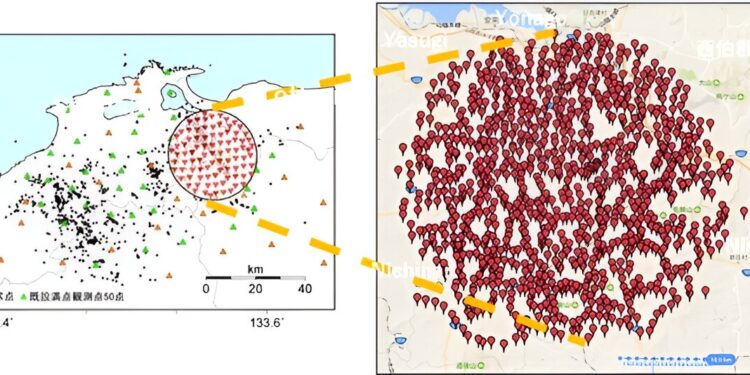Researchers at Kyushu University deployed 1,000 seismic stations in the area surrounding the epicenter of the 2000 West Tottori earthquake, enabling seismic observations of unprecedented precision. Credit: Satoshi Matsumoto, Kyushu University
Located on the Pacific Ring of Fire, Japan is one of the most earthquake-prone countries in the world. Thousands of small earthquakes occur each year, and there is a constant threat of a “big” one. It is currently impossible to predict when major earthquakes will occur, but by studying the many small earthquakes that do occur, Japanese seismologists hope to better understand the processes occurring in the Earth’s crust that lead to major earthquakes.
Researchers from Kyushu University and the University of Tokyo in Japan have studied seismic activity at an unprecedented level of detail, identifying a link between fault strength and earthquake magnitude. Nature CommunicationsThe study suggests that the strength of the fault affects the b value, and therefore the probability of a major earthquake.
“The b value is a very important constant in seismology that characterizes the relationship between the frequency and size of earthquakes,” said Professor Satoshi Matsumoto, first author of the study and director of the Institute of Seismology and Volcanology at Kyushu University. “A low b value means there is a higher proportion of large earthquakes, while a high b value means there is a higher proportion of smaller earthquakes.”
The b value can vary across locations and also over time. It is often reported to decrease just before a major earthquake. A previous study suggested that the decrease in b value was caused by increasing stress forces on the fault. This study now suggests that fault strength is also a contributing factor.
In this study, the research teams analyzed the seismic action occurring in the area around the epicenter of the 2000 West Tottori earthquake with a magnitude of 7.3. By installing more than 1,000 seismic stations in the area, the researchers were able to conduct seismic observations with an unprecedented level of precision.
“Even two decades later, hundreds of tiny aftershocks still occur, most too small for us to feel,” Matsumoto says.
When the Earth’s crust contains many weak faults that are randomly oriented, large earthquakes are unlikely to occur. In contrast, when the Earth’s crust contains many strong faults that are oriented in a characteristic direction, the probability of a large earthquake occurring is higher. Credit: Satoshi Matsumoto, Kyushu University
With so many sensors, the researchers were able to detect the slightest movements of the faults, as well as the orientation of each fault in the Earth’s crust.
Using this wealth of data, the team was able to estimate the stress field (the different directions of stress forces exerted on each fault at the time of rupture) and allowed them to characterize the faults as strong or weak.
“Under certain stress conditions on each tectonic regime, there is a favorable direction of the fault plane for slip. When the faults are in unfavorable directions, it suggests that they are weak faults that can slip more easily. In contrast, strong faults require more stress to slip and have a much more characteristic direction,” Matsumoto explains.
From the stress field calculations, the researchers were also able to estimate the b value of the group of events classified by fault strength. They found that stronger faults have smaller b values, suggesting that large earthquakes are more likely to occur, while weaker faults have larger b values, suggesting that major earthquakes are less likely.
“Simply put, these weak faults are likely to slip before a large amount of stress builds up, meaning they are not capable of releasing a large amount of force,” Matsumoto says.
With a better understanding of the factors that influence b values, researchers hope to move closer to the “holy grail” of earthquake prediction.
“I don’t think we’ll ever know exactly when an earthquake will occur, but analyzing data such as fault direction and strength, as well as calculating b-values, could help us estimate when a fault has reached a critical point, where just a tiny bit of extra force is needed for the fault to slip,” Matsumoto concludes. “This information is essential for preparing for major earthquakes.”
More information:
Satoshi Matsumoto et al., Strength dependence of frequency-magnitude distribution in earthquakes and implications for stress state criticality, Nature Communications (2024). DOI: 10.1038/s41467-024-49422-7
Provided by Kyushu University
Quote:Most detailed study of seismic activity to date links fault strength to likelihood of large earthquakes (2024, September 9) retrieved September 9, 2024 from
This document is subject to copyright. Apart from any fair dealing for the purpose of private study or research, no part may be reproduced without written permission. The content is provided for informational purposes only.



